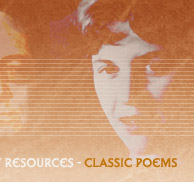|
Ernest Dowson is buried in the Brockley and Ladywell
Cemetery in South-East London, England.
Dowson was the purest representative of the literary
movement of the 1890s referred to as the ‘Decadence.’
His life of exquisite verse, classical learning, French
travel, dissolution, blighted love and Catholic
conversion made him the archetypal 1890s character even
before he set the seal on his iconic status with an
early death.

Ernest Dowson's Grave
(Photo by Philip Walker)

Ernest Dowson
Dowson had no formal education but some tutoring as
his family travelled around the resorts of Europe
seeking respite for his father’s tuberculosis. Though
deficient in other areas of knowledge, Dowson became a
fine linguist and a lover of the verse of Horace,
Catullus and Propertius who were significant influences
on his writing.
He spent five terms at Oxford then was called back to
London to help out with the family’s failing dry dock
business in London’s East End. Dowson wrote poetry from
his teenage years; from the start working on themes of
love and death. Later in life he was to include
religious elements, pointing towards the genuineness of
his conversion to Catholicism that took place in 1891.
He was a regular part of the London literary and
drinking scene from 1888, he contributed to The Yellow
Book and The Savoy and both Books of the Rhymers’ Club.
The Rhymers brought him into regular contact with such
leading characters as W.B.Yeats,
Arthur Symons, Ernest Rhys, Richard Le Gallienne, John
Davidson, John Gray and Lionel Johnson. He was also a
friend of Wilde and a supporter
of him at the time of his trial and after his release
from gaol. He knew Verlaine
and spent much time in his later years, after the
financial failure of the family dock, in Paris and
Brittany. He was frequently a companion of Leonard
Smithers who published his later writing and gave Dowson
work in translating erotic French novels.
Dowson had a fascination with girl children which was
considered eccentric rather than deviant to his
contemporaries. He fell in love with the young daughter
of a Soho restaurant owner, Adelaide, to whom his first
book of verse and his book of stories are dedicated.
After six years of uncertain courtship her marriage to
another man, coupled with Dowson’s parents’ deaths
(perhaps both from suicide) precipitated the poet’s
final decline. He died in R.H.Sherard’s home in Catford,
from tuberculosis exacerbated by his depression and
alcoholism, at the age of thirty-two.
He had lived for little but literature, dying with
virtually nothing to his name but the clothes he stood
up in and his tattered manuscript book of verse. In A
Comedy of Masks, one of the novels he co-wrote with
Arthur Moore, he depicts Oswyn, an intense, drunken,
bohemian character who gives a creed which is so close
to Dowson’s that it seems to be a self portrait. Oswyn’s
personal failings are not intended to diminish his moral
stature as an artist. He says,‘I may fail or I may
succeed, as the world counts those things. It is all the
same: I believe in myself.’
Written by Jad Adams |







